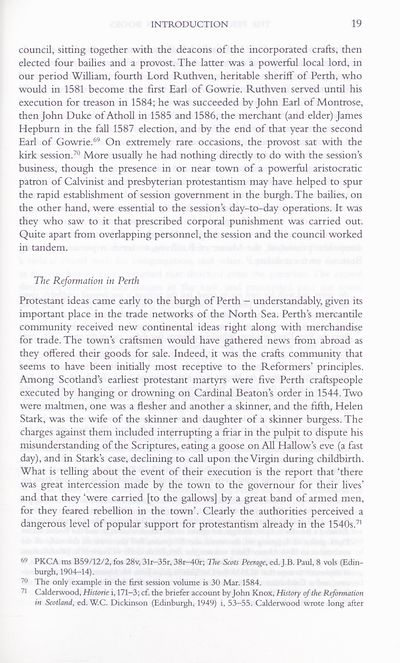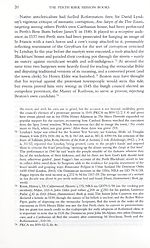Series 6 > Perth Kirk Session books, 1577-1590
(34) Page 19
Download files
Complete book:
Individual page:
Thumbnail gallery: Grid view | List view

INTRODUCTION
19
council, sitting together with the deacons of the incorporated crafts, then
elected four bailies and a provost. The latter was a powerful local lord, in
our period Wilham, fourth Lord Ruthven, heritable sheriff of Perth, who
would in 1581 become the first Earl of Gowrie. Ruthven served until his
execution for treason in 1584; he was succeeded by John Earl of Montrose,
then John Duke of Atholl in 1585 and 1586, the merchant (and elder) James
Hepburn in the fall 1587 election, and by the end of that year the second
Earl of Gowrie.69 On extremely rare occasions, the provost sat with the
kirk session.70 More usually he had nothing direcdy to do with the session’s
business, though the presence in or near town of a powerful aristocratic
patron of Calvinist and presbyterian protestantism may have helped to spur
the rapid establishment of session government in the burgh. The bailies, on
the other hand, were essential to the session s day-to-day operations. It was
they who saw to it that prescribed corporal punishment was carried out.
Quite apart from overlapping personnel, the session and the council worked
in tandem.
The Reformation in Perth
Protestant ideas came early to the burgh of Perth - understandably, given its
important place in the trade networks of the North Sea. Perth’s mercantile
community received new continental ideas right along with merchandise
for trade. The town’s craftsmen would have gathered news from abroad as
they offered their goods for sale. Indeed, it was the crafts community that
seems to have been initially most receptive to the Reformers’ principles.
Among Scodand’s earhest protestant martyrs were five Perth craftspeople
executed by hanging or drowning on Cardinal Beaton’s order in 1544. Two
were maltmen, one was a flesher and another a skinner, and the fifth, Helen
Stark, was the wife of the skinner and daughter of a skinner burgess. The
charges against them included interrupting a friar in the pulpit to dispute his
misunderstanding of the Scriptures, eating a goose on All Hallow’s eve (a fast
day), and in Stark’s case, declining to call upon the Virgin during childbirth.
What is teUing about the event of their execution is the report that ‘there
was great intercession made by the town to the governour for their lives’
and that they ‘were carried [to the gallows] by a great band of armed men,
for they feared rebellion in the town’. Clearly the authorities perceived a
dangerous level of popular support for protestantism already in the 1540s.71
*9 PKCA ms B59/12/2, fos 28v, 31r-35r, 38r-tOr; The Scots Peerage, ed. J.B. Paul, 8 vols (Edin¬
burgh, 1904-14).
70 The only example in the first session volume is 30 Mar. 1584.
71 Calderwood, Historic i, 171-3; cf. the briefer account by John Knox, History of the Reformation
in Scotland, ed. W.C. Dickinson (Edinburgh, 1949) i, 53-55. Calderwood wrote long after
19
council, sitting together with the deacons of the incorporated crafts, then
elected four bailies and a provost. The latter was a powerful local lord, in
our period Wilham, fourth Lord Ruthven, heritable sheriff of Perth, who
would in 1581 become the first Earl of Gowrie. Ruthven served until his
execution for treason in 1584; he was succeeded by John Earl of Montrose,
then John Duke of Atholl in 1585 and 1586, the merchant (and elder) James
Hepburn in the fall 1587 election, and by the end of that year the second
Earl of Gowrie.69 On extremely rare occasions, the provost sat with the
kirk session.70 More usually he had nothing direcdy to do with the session’s
business, though the presence in or near town of a powerful aristocratic
patron of Calvinist and presbyterian protestantism may have helped to spur
the rapid establishment of session government in the burgh. The bailies, on
the other hand, were essential to the session s day-to-day operations. It was
they who saw to it that prescribed corporal punishment was carried out.
Quite apart from overlapping personnel, the session and the council worked
in tandem.
The Reformation in Perth
Protestant ideas came early to the burgh of Perth - understandably, given its
important place in the trade networks of the North Sea. Perth’s mercantile
community received new continental ideas right along with merchandise
for trade. The town’s craftsmen would have gathered news from abroad as
they offered their goods for sale. Indeed, it was the crafts community that
seems to have been initially most receptive to the Reformers’ principles.
Among Scodand’s earhest protestant martyrs were five Perth craftspeople
executed by hanging or drowning on Cardinal Beaton’s order in 1544. Two
were maltmen, one was a flesher and another a skinner, and the fifth, Helen
Stark, was the wife of the skinner and daughter of a skinner burgess. The
charges against them included interrupting a friar in the pulpit to dispute his
misunderstanding of the Scriptures, eating a goose on All Hallow’s eve (a fast
day), and in Stark’s case, declining to call upon the Virgin during childbirth.
What is teUing about the event of their execution is the report that ‘there
was great intercession made by the town to the governour for their lives’
and that they ‘were carried [to the gallows] by a great band of armed men,
for they feared rebellion in the town’. Clearly the authorities perceived a
dangerous level of popular support for protestantism already in the 1540s.71
*9 PKCA ms B59/12/2, fos 28v, 31r-35r, 38r-tOr; The Scots Peerage, ed. J.B. Paul, 8 vols (Edin¬
burgh, 1904-14).
70 The only example in the first session volume is 30 Mar. 1584.
71 Calderwood, Historic i, 171-3; cf. the briefer account by John Knox, History of the Reformation
in Scotland, ed. W.C. Dickinson (Edinburgh, 1949) i, 53-55. Calderwood wrote long after
Set display mode to:
![]() Universal Viewer |
Universal Viewer | ![]() Mirador |
Large image | Transcription
Mirador |
Large image | Transcription
Images and transcriptions on this page, including medium image downloads, may be used under the Creative Commons Attribution 4.0 International Licence unless otherwise stated. ![]()
| Scottish History Society volumes > Series 6 > Perth Kirk Session books, 1577-1590 > (34) Page 19 |
|---|
| Permanent URL | https://digital.nls.uk/127281045 |
|---|
| Description | Over 180 volumes, published by the Scottish History Society, containing original sources on Scotland's history and people. With a wide range of subjects, the books collectively cover all periods from the 12th to 20th centuries, and reflect changing trends in Scottish history. Sources are accompanied by scholarly interpretation, references and bibliographies. Volumes are usually published annually, and more digitised volumes will be added as they become available. |
|---|


